14 Best Practices for M365 Email Security




In the digital age, email has become a critical component of business communication. However, with the increasing reliance on email, there also comes an increased risk of security breaches. Microsoft 365 (M365) users must prioritize email security to protect sensitive data and maintain the integrity of their communications. Here are 14 best practices to enhance M365 email security:
1. Enable Multi-Factor Authentication
One of the most effective ways to secure M365 email accounts is by enabling multi-factor authentication (MFA). This adds an extra layer of security, requiring users to provide additional verification beyond just a password.
2. Utilize Secure Scores
Microsoft's Secure Score provides insights into your organization's security posture. Regularly checking and improving your Secure Score can help identify and mitigate potential risks.
3. Configure Anti-Spam and Anti-Malware Policies
It's essential to configure robust anti-spam and anti-malware policies to prevent malicious emails from reaching users' inboxes.
4. Implement Email Encryption
Encrypting sensitive emails ensures that only authorized recipients can read the content, even if the emails are intercepted.
5. Regularly Update Password Policies
Strong and unique passwords, changed periodically, are crucial for maintaining email security. Encourage users to create complex passwords and update them regularly.
6. Utilize Email Archiving
Email archiving helps retain important emails while reducing the risk of data loss. It also aids in compliance with regulatory requirements.
7. Enable Audit Logging
Enabling audit logging allows administrators to track and monitor email activity, helping to identify any suspicious or unauthorized access.
8. Train Employees on Email Security
Regular training on email security best practices is vital. Employees should be able to recognize and avoid phishing scams, malicious links, and other threats.
9. Implement Data Loss Prevention (DLP) Policies
DLP policies help prevent sensitive information from being accidentally leaked via email.
10. Use Safe Links and Safe Attachments
M365's Safe Links and Safe Attachments features help protect users from malicious links and attachments in emails.

11. Configure Mobile Device Security
With the increasing use of mobile devices for email access, it's crucial to ensure that these devices are securely configured.
12. Monitor and Review Email Traffic
🔔🔔🔔
【AOTsend Email API】:AOTsend is a Managed Email Service for sending transactional emails. Support Email Types: reminders, authentication, confirmations, notifications, verification codes, invoices, password resets, account activations, billing statements, two-factor authentication (2FA), and one-time passwords (OTP) emails, etc. $0.28 per 1000 Emails. 99% Delivery, 98% Inbox Rate.
You might be interested in:
Why did we start the AOTsend project, Brand Story?
What is a Managed Email API, How it Works?
Best 25+ Email Marketing Platforms (Authority,Keywords&Traffic Comparison)
Best 24+ Email Marketing Service (Price, Pros&Cons Comparison)
Email APIs vs SMTP: How they Works, Any Difference?
Regularly monitoring and reviewing email traffic can help identify any unusual or suspicious activity.
13. Implement Email Retention Policies
Email retention policies help manage email lifecycle and ensure that sensitive data is not retained indefinitely.
14. Leverage Advanced Threat Protection (ATP)
ATP provides additional layers of protection against advanced threats, including phishing and ransomware.
By following these best practices, organizations can significantly enhance the security of their M365 email environment. Remember, email security is not just about technology; it also involves educating users and creating a culture of security awareness.




Scan the QR code to access on your mobile device.
Copyright notice: This article is published by AotSend. Reproduction requires attribution.
Article Link:https://www.mailwot.com/p1909.html



